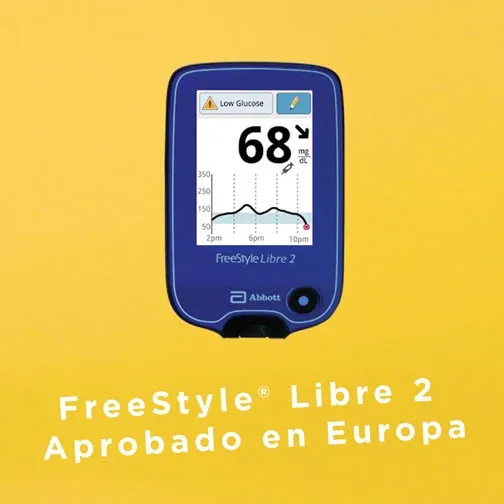I think it is appropriate to tell you my experience for which you may be interested and you can help you download your frustration a bit.I only intend to shed a little light on such a deal in the RRSS and on the other hand, so unfortunately clarified by doctors, which is the correct use of inserty sensors.The RRSS have a problem in my opinion.And everyone thinks.It doesn't matter if you know or not.Have enough experience or no.No one mentions the sources of information, much less think about the consequences that something can have in a place that is public.For me it is of a degree of selfishness only matched by ignorance.And they are the groups of people who, believing together what others publish based on their own conclusions, give them voice replicating their same opinions and making others believe that this is truthful and proven information.It makes me angry every time I read someone to give birth to a product or brand and I think that since I one day they read that kind of comments and made them feel a bit lost and helpless ...
We start.My DT has 12 years of evolution.I started capillaries only before and after lunch.At dinner and at breakfast I decided to see my readings (before the lack of interest on the part of my endocrine) that did not need insulin.Most of the time I was "within the rank", it didn't matter what to eat and put the same amount of rapid insulin, which in my case was 1 unit.I think I had a pronounced and long "honeymoon", but I will never know if I had any of the other DT varieties that I have read there.The corrections were made "blind", because I did not know that they were the ratio or the FSI, and most of the time they ended up in Hicm, which also recovered blindly ... In addition, it had strong symptoms before a hiccUploaded to me that I got out of the range, which made me live with some peace of mind within my ignorance.
It was then (after about 6 years of DT) when I launched to try the free.At first (as I imagine, many of you have happened to you) that was enlightening and at the same time worrying to see the controls.What I had always believed that they were stable and maintained glycemia after 2 h post food became curves that, then, seemed to be nonsense (uploads and descents outside of meals, periods in and HI maintained, etc.).In addition, sometimes, when you made a capillary, the readings did not look like those of the sensor, with variations of up to 50 mg/dl after eating.I was frustrated not knowing if the culprit was me, the sensor, or a combination of bad luck.Of course, I realized that my DT was not as controlled as I supposed and that I had to pay more attention.On the other hand, at that time I realized that the Lantus insulin fell "short" and did not get well to dinner, which would have been difficult to detect only hair.
But I still had the hope that everything was a "lie" caused by the little reliability of the sensor readings and thus I began to participate in groups of FB users and read other people's experiences looking for the advice that the assumptions gave "experts ".Well, the vast majority (except for exceptions) said that the sensor readings were not only reliable but could only serve as a guide to complement (and never replace) to a blood glucose meter, that is, it served forSee trends and little else.For a long time I really believed that this was like that and I went on to use the sensor in that way, giving little importance to what the readings told me.In fact, even today I keep seeing professionals to affirm this.On the one hand, this reassures you to see that there are more people than themIt happens the same as you, but at the same time it is a stick, seeing that you feel helpless with time, effort and money invested in a help that is not what you expected.You feel that you will be the same as before, blind, enslaved and making hidden capillaries (at least in my case) for the corners.
Many times, altered largely by the comments of these people, I have paid my frustration with the sensor with the people around me.I also called Abbott several times.In those calls they tried to explain in a good way, without going into technicalities, how the sensor worked and the reason for those deviations in the readings.Ignoring, and again moved by the wonderful recommendations of the forums, always sought to replace the sensor and try again luck with a new one.Many times, the first days with a new sensor seemed that this was the key and everything seemed to make sense.And my frustration went down, I began to feel better with myself, but not for long ... again some influence factor intervened in the DT (I ate some food with more HC, varied my level of stress or practiced a physical activity more or lessintense) and that fell apart.The faults were of course again for the sensor (as he had learned in the forums) and the nightmare began.I saw how time passed and used more and more effort trying to convince me that someone would arrive with the magical wand and give me the solution to the problem.On the contrary, there were more and more people asking lost, desperate and frustrated with the subject like me.And the answers were the same as always ...
Since that has spent time and fortunately, I left those circles.I attended talks about technology in DT.I read articles on interstitial glucose measurement written by people who are based on studies, how it really works.I realized that in the periods in which insulin takes effect or when you practice exercise it is important to know how to interpret curves and delays in sensor readings.This completely changed my way of interpreting values and trends and automatically changed my decision making for treatment.The control of my diabetes would improve a lot, and therefore my level of stress, but I still have some issues to be resolved.One of the pending issues was that of the imprecision of the readings when you are a little higher or a little lower than the account and therefore the need to have to verify those readings making a capillary.
The other theme arises as my diabetes has become increasingly rebellious.The honeymoon vanished, I was no longer worth the methods that I used and the thing began to get serious.I no longer had symptoms from hypoglycemia and my body did not differentiate a mild rise from hyperglycemia.I had to learn to calculate ratios, FSI, adjust insulin doses and count HC on my own.And I was not at all in the controls.But one thing that burst me is not having a notion of my control until the reader passed by my arm.That meant that at any time I could be having a hiccup or hyper without realizing it.But not only that, but I could be tending to hip or hyper and not being doing anything to remedy it.One more stage of frustration began in which I felt the need to spend the reader all the time.I began to get very nervous if I saw that I had an ascending or descending trend.I also got nervous if I spent time without taking a reading (as in work, for example, or going running).
It was then when I decided to look for information to turn the free into a continuous meter using a transmitter, because I had read several influential people who used it with good results.
UntilNow he had ruled out that option for 2 reasons.One was that it seemed uncomfortable, since the sensor itself is already for me and carrying something more bulky on top of it, in addition to increasing the chances of getting hooked.In the course of myself, a sensor has never taken off without being motivated by a blow.
The other reason is the measurement system that uses Miaomiao: it receives the raw values of the sensor and then uses a calibration line to give "sense" to those values.There is no ABBott algorithm there...
I decided to try the XDrip app and returned to the FB groups to inform me.Unfortunately, the situation with the users was the same as with the free ... people complaining desperate for not knowing how to configure the application to obtain readings and throwing all the faults the system that acts as a transnmior ...
My experience is that I did myomiao2 official with XDRIP, not without giving me several batacazos with the application caused by an excess of desire to obtain at all costs the readings, again very conditioned by what I had read in the comments of the people.In the end Miaomiao is a good product, if you let him do leaving him the time he needs to work.I got a smartwatch with Wear OS and managed to have the readings on the clock autonomously and independent of the mobile phone.
I began to carry out calibrations and understand how they influence the readings (paradoxically in my profession I dedicate myself to something related to this).I saw that they could mean greatly improving the accuracy of the sensor (until they dispense with capillaries) or ending up having a system that harms you in your control rather than helping you.It is extremely important to know how to make calibrations correctly if you want to have a minimally reliable reading.Today I think it is the great defect of this system and the one that causes you, for example, that the first day of use of a sensor increases the degree of stress until you do not have a decent calibration.
And then the free2 arrived and by magic, the need for a transmitter and calibrations disappeared ... but I leave this for another day I want to write it and I give you a break to reconsider.
During all this time, based on peeling with this system and therefore with my illness and with moments of great frustration, I have gone little by little knowing what are the weaknesses that this measurement system has and how it behaves in each of thesesituations (showers, posture changes in bed and sofa, temperature changes, etc).And I have to say that in my case, we have made the sensor and me peace.Today we have a system that is capable of matching the hair measurements in blood with all that it entails.I just hope that the industry will soon market what is already a reality at the technical level.
Thank you, a greeting.




